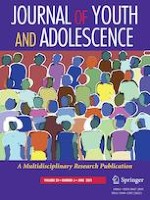22-01-2021 | Empirical Research
The Relationship Between Dating Status and Academic and Social Functioning in Middle Adolescence
Gepubliceerd in: Journal of Youth and Adolescence | Uitgave 6/2021
Log in om toegang te krijgenAbstract
Dating relationships are normative in middle adolescence, but the academic and social implications of different types of dating involvement remains unclear. To address this gap, this longitudinal study evaluates the association between dating status (i.e., never date, rarely date, casually date, steady relationship) and academic and social functioning in a sample of adolescents. Across two school years, 455 adolescents (53.8% female; 56.5% Asian American, 43.5% Latinx; T1 Mage = 15.04 years) reported on their dating status and peers provided nominations of popularity and aggression. Grades and standardized test scores were obtained from school records. For Asian American youth, abstaining from dating was negatively associated with subsequent popularity. Casual dating and being in a steady relationship were associated with relational and overt peer aggression over time. Gender moderated this association, such that boys in steady relationships, and girls in casual relationships were more relationally aggressive one year later. Implications are discussed in terms of problem behavior theory and adolescent intersexual competition.
